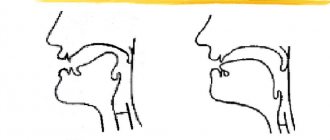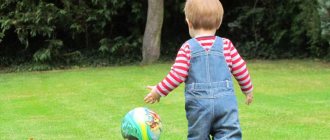Now there will be a slightly non-standard post for my IT website. But maybe my experience will be useful to someone!
Until the age of 25, I burred at R and L. But at the same time, I did not burr at the soft letters Rb and L. I learned to pronounce the letters R with my throat so well that people understood me quite well, although I didn’t say such terrible words as ENT and Laravel, which sounded extremely strange to me :)
I did not replace words with R with words without R, i.e. For me, fish was fish, not a herring, and work was work, not “business.” At the same time, I tried to pronounce R, and in some cases people simply swallowed the sound.
As a child, I thought that I simply could not pronounce R correctly; I did not even realize that it should be pronounced with the tongue, and not with the throat. In adolescence, I realized that I was addicted to the needle of “burr” and this illness could not be gotten rid of so easily. But it didn’t cause me any problems, and the people around me were quite normal about it.
By the way, there was no speech therapist at school, and no one told me about the burr until I realized it myself.
First problems.
The first problems began while serving in the army. This was in 2011. At that time, there was a program on TV about Bearded Man, a security guard from a store. Remember? So, he lisped. I didn’t burr that much, but I could easily parody the Bearded Man. Many colleagues asked me to say: Alexandergggg Gggodionovich Boggodach. It was funny, I wasn’t offended by it, people made good jokes, but of course I was pretty tired of it.
But after the service, everything returned to normal and no one said anything about it. Well, maybe behind your back, as we like 
At 25 years old, burr cannot be corrected. Late. You will not make it.
How many times have you heard this? I think a lot. But what you do is up to you. If you want to achieve or do something, then sooner or later you will reach your goal. If, of course, you go to her. In 2021, I began to think about correcting burr at home, without visiting a speech therapist (but in vain... read). This was around the beginning of April.
My wife's grandmother is a speech therapist. And from her I heard that there is practically no chance of correcting burr in an adult. I heard the same thing on forums and YouTube. The funny thing is that on YouTube people talk about how to get rid of burr, but at the same time they themselves have never burred. 
I think the best speech therapist is the one who burred himself and got rid of the burr himself. He will definitely be “on topic”. But such speech therapists do not exist on this planet. Just a joke, of course.
Music for learning grazing
A very good way to become a person who can burr is French music. Some artists even use too much grease to give their songs the most appeal. The music of such performers will be the best option for learning burry pronunciation.
Especially if a person knows how and loves to sing, then such an activity will bring a lot of pleasure and at the same time benefit. You just need to choose songs you like, which you can do online or by purchasing a CD of French music in a store.
A little introductory information from a burr with experience.
Burry people speak from their throats. I also spoke. This makes for a completely different sound. Just as the throaty R is unusual for you, the tongue-tip R is unusual for the burr. But it is not necessary to burr at all sounds, both hard and soft. I already talked about this above. I had practically no problems with R, as well as with L.
But this does not mean that R was easy. These sounds are pronounced completely differently. Like L and L. Do you think it’s possible to burr with L? It’s easy, try to pronounce it with your throat: press the root of your tongue to your upper jaw and try to say L. Yes, yes...
Exercises for consolidation
When your baby manages to pronounce the long-awaited letter, be sure to continue training to consolidate it. They should be carried out at least 3 times a day.
What do we have to do:
- Pronounce syllables with “r”. For example: “ra-ra-ra”, “ru-ru-ru”, “ro-ro-ro”, “ry-ry-ry”. Next we connect different syllables: “ru-ra-ry”, “ra-re-ro”, etc.
- To complicate the task, pure phrases are used:
- “ra-ra-ra, ra-ra-ra, I was with the guys yesterday”;
- “re-re-re, re-re-re, everyone was playing in the yard”;
- “ru-ru-ru, ru-ru-ru, the mouse dug a hole”;
- “ro-ro-ro, ro-ro-ro, suddenly the feather got lost”;
- “ur-ur-ur, ur-ur-ur, we chased chickens yesterday.”
- Play animals. For example, you can growl like a dog and a tiger, purr like a cat, croak like a crow.
How I corrected burr as an adult: at 25 years old.
Attention, I am not a speech therapist and I don’t know if I did everything right. It helped me and that's the most important thing!
To be more precise, I started correcting my burr in April, when I was still 24 years old.
I approached this matter with all responsibility and I was extremely tired of my wife, but I thank her for her patience.
Where did I start? People who burr as adults also burr when they think . But you don’t need to deceive yourself and say that this is not so. This is true :) After all, when we think, we try to say something about ourselves with our voice. And for a person who cannot pronounce R, it is impossible to even imagine how it would sound from his lips.
April 2021: forget about throat R.
So the first thing was to get rid of the burr in my head. This is just a psychological moment that I spent a whole month on. It sounds strange and funny, but this helped in the future not to be confused between the throaty R and the R pronounced in the correct way. Although I was still confused for the first month, when I started talking to people correctly, very quickly I forgot about the throat R, in about a week.
Next, I began to try to reconfigure the articulatory apparatus to pronounce R. I did this through J. Tritely at home, when communicating I pronounced instead of the word Gggossia (Russia), Zhossia, Gabota was transformed into Jabota and so on. This took me about two weeks.
Then I stopped suffering from bullshit and began to study hard. It was already towards the end of May 2021.
May 2021: trying to install an isolated R sound at home (it didn’t work).
By the way, if you didn’t burr and the thought arises in your head: well, it’s so easy to pronounce R! What's difficult here? That's all right. My wife had the same thought. She pronounces all the sounds of the Russian alphabet very clearly, I asked her to open her mouth and try to pronounce the sound R. It’s funny! But I clearly saw how this sound should be pronounced.
And this sound appears due to the vibration of the tip of the tongue against the teeth and alvioles. I tried this way and that, but over time the tongue found the correct position for pronouncing R. Have you thought about this? For me this position is between the incisors and alvioli. In the middle.
I asked her, how do you do it? The answer, of course, was killing me: it’s itself, I can’t even explain it.
Looking ahead, I will say that you need 10,005,000 hours of training the tongue muscles. The tip of the tongue should vibrate even when blowing lightly on it. The only way. It was only through pain and training (yup) that I developed the R sound. I rolled my tongue, I bit it, I brushed it, I did exercises from the internet, and so on. Plus you need to remember about the air flow, it should be directed towards the tip of the tongue. Well, after 100 lessons you will have it automatically :)
How to learn to burr
First of all, you need to start from your goals. Burrs in the French and German styles are very different, which means that the exercises need to be performed differently.
It's a completely different matter if you plan to burr in Russian. There are completely different rules here, and everything depends on the position of the speech apparatus. The speech therapist will tell you in more detail in the video below. There are 14 variations on how to burr the letter r.
Exercises to burr the letter r
There are special exercises developed by French teachers. With their help you will be able to pronounce the letter “P”.
- Stand in front of a mirror to see how your speech apparatus works. Press the middle of your tongue against the roof of your mouth and touch the tip of your tongue to your lower jaw. Try saying "r".
- With the base of your tongue, touch the roof of your mouth and pharynx, tighten it as much as possible. Pronounce the correct letter.
- Take a glass of water. Gargle while pronouncing the sound “r”. Remove water from the exercise and try to repeat the steps without it. The result should be a vibrating sound.
Do the exercises regularly and carefully monitor the results. Over time, you will notice changes, but be prepared that it will take time.
German pronunciation
There are three ways to say "r" in German. The pronunciation option depends on the letters in the spoken word. Such sounds are not found in Russian, so you will have to learn them from scratch.
- Looks like a slight burr. The sound is different from the soft French sound. After all, German is a rather tough language. The pronunciation is average between the Russian “r” sound and the Parisian one.
- Hissing "r". The letter has no analogues in the Russian language, but in pronunciation it resembles the soft “хь”. You need to pronounce this sound with a formed sharp exhalation, otherwise it will be hard to hear.
- The growling sound is very similar to Russian. Used only in the south of the country, especially popular in Bavaria.
To practice, you need to often listen to German speech and try to repeat the sound. There is no other way of learning.
If you want to learn German, we have an article on this topic.
French pronunciation
The language is soft and melodic, so in French you need to pronounce the letter “r” with a pleasant burr. You need to gradate the sound, as is customary in Paris.
In provincial towns, the usual dialect with the letter “r” is often used. So it’s not at all necessary to burr like a true Parisian if you’re just learning the language for tourist purposes.
The French language differs from German and English in that the letter “r” is read at the end of the word and is never lost.
When pronouncing, you do not need to close your lips tightly. Turbulent turbulence must be created in the mouth, with the help of which the desired sound is produced. In the Paris version there should be no vibration or friction noise, it should be completely slotted.
With correct articulation, movement of the edge of the soft palate, less often the back surface of the tongue, is implied. And the small tongue should be in a tense state, but not vibrate.
Listen and repeat
People are very good at imitation and repetition, and for this you need to constantly listen to burrs. You know exactly what you want to achieve, so choose a source of inspiration and listen to:
- French songs with a Parisian accent (for example, Edith Piaf with “Non, Je ne regrette rien” or Mireille Mathieu “La vie en rose”);
- speakers who clearly pronounce the grazing “r”;
- German speech with different variations of pronunciation;
- listening to tongue twisters in the desired language that contain the letter “r”;
- the speech of a burry person whose speech you like.
This is the easiest and most natural way to study burr. This is how children learn, which means learning is also suitable for adults.
Exercises for correct pronunciation
First you need to work on pronouncing the letter "r" simply. Later, move on to studying syllables and words. Indeed, depending on the location of the letter (beginning, end, middle), it varies.
The first thing you need to do is listen to words with different placements of “r”. Repeat after the announcer, then simultaneously, and then without him. Record your pronunciation on a voice recorder to hear yourself from the outside. Do it at least twice a day.
Choose a speech that is pleasant to listen to.
In addition, you can use the “mine” exercise. It is so named because the word “mine” must be pronounced while performing it. Repeat several times and watch the pronunciation of the “x” sound.
Remember the position of the larynx, and try to replace the dull sound with a voiced one. This is exactly what a graded “r” sounds like.
During further practice, make sure that there are no vibrations when pronouncing words with the letter “r” at the beginning or middle. It can only vibrate at the end.
Another quick way to learn to burr is to do a tongue exercise. Straighten it first and then tighten your backside. In this position, say “r” several times. At the same time, avoid vibrations and tension in the entire tongue - just the beginning.
Tongue Twisters
If you already know the language, you can memorize tongue twisters and sayings that contain many “r” letters. This way you will consolidate the skill and be able to bring the correct pronunciation to automaticity.
Some examples of suitable phrases:
- "Dans la gendarmerie, quand un gendarme rit, tous les gendarmes rient dans la gendarmerie."
- "Mon père est maire, mon frère est masseur."
- “Rat vit riz, Rat mit patte à ras, Rat mit patte à riz, Riz cuit patte à rat.”
First, pronounce them slowly, focusing on the pronunciation of the “r”. Later, increase your speed to communicate normally with the French.
Heavy artillery.
June 2021: watch YouTube, do the same exercises. By the end of June, I was able to pronounce R poorly and isolated. I can’t put R into words, I’m looking for a speech therapist.
I’ll say right away: go to a speech therapist. Not on Skype, not on the phone. Only live, only one-on-one. I learned to pronounce the R sound more/less independently in isolation, but I could not insert this sound into words. It sounded like this: the first part of the word comes, then a pause, then a rolling RRRR, then the rest of the word :)
How long did I study? About 1-2 hours a day. I installed the sound myself in 1.5 months. I spent almost two months on this. Can you imagine?
This old video helped me a lot:
In the third minute there is an exercise with cotton wool. This is one of the best exercises to start pronouncing the R sound using the tip of your tongue. The point is that you must learn to direct a stream of air with your tongue to the tip of your nose, where the cotton wool lies and needs to be blown away. You need to blow on the tip of your tongue to control the air flow.
Next, at the fifth minute, there is a very strange, but coolest exercise to make your tongue vibrate. Just watch the video. This exercise helped me a lot and by the way, I did it to myself, and with the help of this exercise I made the tip of my tongue vibrate so that the first real R sound appeared.
I did all the exercises from the video and it took a month and a half. Although I know a person who has been doing the same exercises for half a year and has no results. Do you know why? He does them 1-2 times a week. Needs to be done every day.
Setting the letter P
The most common method of correction is the gradual production of the sound “r”. Let's take a closer look at it.
The first stage is designed to develop the correct position of the tongue, increase its mobility, and relieve muscle tension. For this purpose, exercises such as:
- “Mushroom” (suction of the tongue to the palate);
- “Painter” (stroking the palate with a relaxed tongue in different directions);
- “Horse” (clicking tongue).
At the second stage, work is carried out to produce a fricative (slit) sound without vibration. It occurs when a strong stream of air passes into the gap at the front edge of the tongue and gums, touching the tip of the tongue. The child is asked to raise the tip of the tongue onto the alveoli (tubercles) and try to pronounce a long “w-w-w”. This allows you to remove the vibration of the soft palate.
It is necessary to perform this exercise in front of a mirror, ensuring the correct position of the tongue. This will also help to clearly show why the child cannot pronounce r correctly.
Long-term pronunciation and repeated consolidation immediately in speech while practicing syllables and words will allow you to eliminate and correct incorrect options, as well as continue to work on the articulatory structure of the “r” sound.
The third stage helps to develop vibration with mechanical assistance so that the baby begins to speak correctly. Using the child's index finger, they move left and right along the lower surface of the tongue while pronouncing the fricative "r". A strong exhaled stream of air will cause the tip of the tongue to vibrate. The impressions from this exercise can stimulate the child so much that he will be able to say a pure sound on his own. But this does not cancel further work on automating the skill.
Introduction of the sound R into speech in an adult.
July, August, September, October - classes with a speech therapist 1-2 times a week + daily classes at home.
4 months - that’s how much I spent to introduce the sound R into my speech. All this time I studied only with a speech therapist. Of course, it was funny when 5-6 year old children were sitting next to them, but what to do?:) The lesson took 1 hour.
How was the session with a speech therapist with an adult:
The first 20 minutes were a warm-up. We quickly went through all the exercises from that video above. By the way, the sequence was also something like this. When performing these exercises, the tongue actually turned blue. Next, we pronounced all the words, where there is simply the maximum number of letters R. At first these were individual words, then there were phrases and whole sentences. Last month these were already texts, for complete automation.
It was much easier for me to pronounce the sound R in reverse, for example: oP, aP, uP, instead of Ro, Ra, Ru. Everything is individual here. Approximately the first two months of classes with a speech therapist, this is 40 minutes of execution with the sound R. Plus classes at home. My brain began to forget throat pronunciation, and after several classes (about 4 classes), I began to introduce R into speech, that is, speak to people correctly. Sometimes embarrassments arose because of the rolling R, for example RRRRRRRWork, instead of Work. Sometimes the tongue gets confused and you burr at one sound, but not at another, but that was the first couple of weeks. 
I understood one “trick”, it’s like learning another language or some kind of technology. Do you want to learn it quickly? Implement it right away. Knowledge without practice is equal to 0, everything is quickly forgotten. It's the same with pronunciation. Don't start talking? Money and time are wasted.
I wasn't afraid of saying something wrong, even though it was funny at times. After all, before that I also pronounced sounds incorrectly. Nothing changes for me. But the result was not long in coming.
By October, I was already calmly talking to people and they didn’t ask me again when something became unclear to them.
What to do if the child does not pronounce “w”?
When pronouncing a voiced “zh,” the vocal cords are involved. The exhaled stream and the tension of the tongue during sound are weak. The tip of the tongue trembles and vibrates a little under the influence of the air stream. If the child’s tongue is not mobile enough or is sluggish, then specially selected preparatory exercises are necessary.
The sound “zh” is complex in its articulation, so children master it relatively late and often pronounce it incorrectly or unclearly even by the end of preschool age. There are several options for incorrect pronunciation of this sound: either it is completely missed, or pronounced unclearly, or replaced with another (most often “z”).
Violation of the sound “zh” is in most cases correctable, and often this deficiency is eliminated relatively easily. But an indispensable condition is the regularity, systematicity of the exercises and the desire of the child himself to correct his speech and begin to pronounce “w” correctly.
Before starting classes, you need to check whether the baby’s phonemic hearing is sufficiently developed, that is, whether he can distinguish hissing sounds from other, similar sounds. To test and train phonemic awareness, it is useful to ask the child to come up with words with the sounds in question. Select pictures whose names contain these sounds, and work out with your child the meaning of words that differ in one sound.
Warm up for the tongue
To better pronounce sounds, you can use a tongue warm-up, which consists of the following exercises:
- First, we round the lips, the teeth do not close, the edges of the tongue are pressed against the teeth, and the tongue itself forms a scoop. Exhale with added air while making a hissing sound.
- Spread your tongue wide, bend its tip and stick it out with raised side edges.
- Raise the protruding tongue alternately to the upper and lower teeth, to the upper and lower lip.
- “Accordion” to strengthen the muscles of the tongue in a vertical position: open your mouth, smile, and press your tongue to the roof of your mouth, open and close your mouth 5 times.
- “Pie”: open your mouth and smile, curl your tongue, lifting the edges, count to 15, and then repeat.
Warm up for lips
Lips play an important role when pronouncing hissing words. They should stretch forward with their proboscis. But it is not possible to give such a shape to the lips right away. You will have to resort to articulation exercises again:
- lips slightly rounded;
- “smile” - smile so that the upper and lower teeth are visible and hold this position for 7 seconds;
- “tube” - stretch out the lips with a tube.
Basic methods for producing the sound “zh”
Staging sound is the development of new connections in the child and the inhibition of previously incorrectly formed ones. Methods that can help make the sound “zh” include:
The first method is by imitation, when the child’s attention is focused on the movements and positions of the articulatory apparatus.
The second method is mechanical. It is used when the child lacks visual, auditory and tactile-vibration control.
The third method is mixed, when all possible methods are used to achieve the final goal - setting the correct pronunciation of an isolated sound.. With all these methods of setting any sound, verbal instructions, kinetic sensations, visual, auditory, tactile-vibration control and reference sounds are always used
With all these methods of producing any sound, verbal instructions, kinetic sensations, visual, auditory, tactile-vibrational control and reference sounds are always used.
To practice the letter “zh” you can resort to the following exercises:
- Pure saying: “ZHA-ZHA-ZHA. We saw a hedgehog. ZHA-ZHA-ZHA. The hedgehog has spines. ZHA-ZHA-ZHA. I found a hedgehog. ZHI-ZHI-ZHI. Hedgehogs live in the forest."
- The child must learn to form the plural of nouns - garage-garages, knife-knives, snake-snake, etc.
- “The beetle is buzzing” - the child needs to imagine how the beetles are buzzing and imitate this sound. The position of the lips should be correct - rounded and slightly pushed forward. The wide part of the tongue rises to the tubercles behind the upper teeth, and a warm air stream should come out of the mouth.
You can see how speech therapists work with children to produce the sound “zh” in this video:
What's the result?
Half a year of classes. A lot of wasted time and nerves. These are the disadvantages. Now the advantages are the clear pronunciation of the sound R. Even in a whisper. Starting in July, I spoke to people correctly, but went to a speech therapist. It was an important moment and very right for me.
I hope you enjoyed the article and can use my experience to plan your lesson plan. I answer all questions in the comments (quickly) and by email, which is slower. Since I studied on my own and with a speech therapist for a long time, you can at least go and work as a speech therapist yourself :) If you have any questions, ask!
Learning to pronounce the sound R correctly: sound automation
Even if the “engine” starts, it is very difficult to automate it into fluent speech, since the sound R is considered the most insidious.
How to correct speech defects? Before bringing P to automaticity in words, phrases, sentences and in speech in general, you must first teach the baby how to connect this sound with others: vowels and consonants. Next, let's look at ways to set the sound R. First, practice R through lightweight D and T in syllables such as:
- "tro/three/tra";
- "dro/dri/dra".
The children's language, “starting” from these hard sounds, gradually moves to R. Then introduce the reverse syllables: “ro/ri/ra” - “or/ir/ar”. Until the baby is able to repeat R in syllables with vibration to the point of automatism, one cannot move on to the next stage.
After clearly completing these tasks, you can move on to words. You should start with words where the letter in question is in front or through the sound combination “tr” (shirt, grass, throne, etc.). Next, proceed to words with a middle and final P (cow, fence).
Then, in a similar way, teach the difference between hard and soft P. As a rule, the baby himself understands the differences and makes sound substitutions. But sometimes you need to explain to him that to soften P it is worth moving the tongue. As a result of all this, R automation is developing.
Tongue Twisters
Let's learn to say the letter R. There are a great many tongue twisters for this purpose. Below we look at the most common ones:
- Grass in the yard, firewood on the grass. Don't cut wood on the grass in your yard.
- Karl stole corals from Clara, and Clara stole a clarinet from Karl.
- Roma was frightened by the thunder; he roared louder than thunder. Because of such a roar, the thunder hid behind a hillock.
- Roma and mom washed the frame and looked at the panorama.
- Prokop has arrived - the dill is boiling. Prokop has left - the dill is boiling. And with Prokop the dill boils, and without Prokop the dill boils.
By the way, you were talking about L. What's with her?
I pronounced it wrong. That's all. As it turned out, you need to press the tip of your tongue against your teeth and try to pronounce the sound L. I spent 2-3 lessons on it + a couple of weeks at home to practice. As young people say: it was absolutely easy :)
But we trained her exactly the same way as R, no concessions. There were words with La, lu, le... and with Al, st, ate....
PS when I burred, I practically did not notice that some people also burred. I was on the same wavelength with them, now I notice.
Articulation gymnastics for the sound R
If you notice that your child’s movements are imprecise, and that he cannot repeat some of them, first teach him to do special exercises for his lips and tongue. They are called articulatory gymnastics and are designed to improve the mobility of the speech organs.
To test your child’s speech hearing, ask him to “catch” the sound R. You alternately pronounce different sounds, syllables and words, for example: P, L, SH, R, S, R, LA, RA, MO, UR, MAMA, RAMA, PAWS , ROSE, and the child should clap his hands when he hears R among them. If the child confuses similar sounds: R-L, R-Y, this indicates a speech hearing disorder.
To check the length of the frenulum of the tongue, ask the child to open his mouth as for pronouncing the sound E and reach the base of the upper teeth with his tongue. If the tongue does not reach, the frenulum is considered shortened. It is quite easy to stretch it with the help of regularly performed exercises for the tongue - “Horse”, “Mushroom”, “Accordion”.
When the sound P sounds “French”, burrously, scientifically this is called grazing, there is a violation of speech exhalation. If it is incorrect, then the air stream partially goes into the nose, and its remnants dissipate in the mouth. As a result, it is not the tip of the tongue that vibrates, but the small tongue above the palate. Grassing is very difficult to correct, and as soon as you notice that the child has begun to burr, immediately begin work on correcting speech exhalation.
Appeal to parents.
Dear parents, if your child has a burr and you sent him to a speech therapist, but after three classes you realize that nothing is improving, do not tell your child about it!!! How can you even say such a thing?
Damn, I heard several times (99% of children have speech therapists) from mothers: son (daughter), most likely nothing will work out for you. We are walking in vain. You're just not like everyone else. Oh, how ashamed I was then for such “mothers.” Unfortunately, there is no other way to call them.
The child is 6-7-8 years old, classes may last a month, but the result will be. You didn’t learn to speak Russian in a week, did you? No? Well, what do you want from the child? You probably don’t even work with him at home, because a speech therapist for 500-600 rubles should do a miracle! Ah, class once a week...
How to check the pronunciation of the sound R?
Ask the child to repeat it several times in isolation - R R R, then in words in different positions after you: CANCER, FISH, HAND, CROW, COW, ROAD, VAR, HEAT, STEAM, TRACTOR, DRAGON, AVENUE.
If a child pronounces an isolated R incorrectly, then you will need to first put it in, then fix the pronunciation in words and sentences. If P sounds correct in isolation, but incorrect in words, you will only need to fix its pronunciation.








